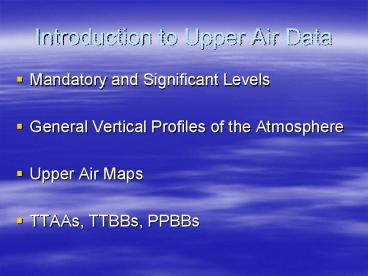Introduction to Upper Air Data PowerPoint PPT Presentation
Title: Introduction to Upper Air Data
1
Introduction to Upper Air Data
- Mandatory and Significant Levels
- General Vertical Profiles of the Atmosphere
- Upper Air Maps
- TTAAs, TTBBs, PPBBs
2
Mandatory vs. Significant Levels
- Mandatory levels are those that will always
appear in upper air analysis gathered from
radiosonde data - Significant levels are levels where there is
significant data to present (usually not
represented with a map but just incorporated on
soundings)
3
Mandatory Levels and Heights
- Surface - obviously
- 1000mb - varies on station elevation
- 925mb - varies on station elevation
- 850mb - 1500m
- 700mb - 3000m
- 500mb - 5500m
- 400mb - 7000m
- 300mb - 9500m
- 250mb - 11000m
- 200mb - 12000m
- 150mb - 14000m
- 100mb - 16000m
4
Upper Air Maps
- This is why knowing heights is important
- Dew point vs. Dew point depression
- Normally temperature decreases with height until
200mb where it becomes isothermal then increases
with height in the stratosphere - Wind increasing with height until the jet stream
(250mb) - There are troughs and ridges like sfc maps
- http//weather.unisys.com/upper_air/mandatory.html
- Details
5
TTAAs and TTBBs
- TTAAs are mandatory level data, temperature, dew
point depression, height of p level, wind speed
and direction is given - TTBBs are significant level data, temperature,
dew point depression, and p level is given - PPBBs are the corresponding wind data with
heights of the significant levels
6
Decoding all that data
- See http//www.ems.psu.edu/Courses/Meteo200/lesson
5/decode.htm - This link shows how to decode all this data and
all the tricks - There are little tests on this page to help
- All this data is displayed in thermodynamic
charts, such as Skew T Log P diagrams - In this class well focus just on TTAA
7
850 mb Maps
- How to decode station models for this level
- Temp plotted upper left in Celsius
- Dewpoint DEPRESSION plotted
- Circle shaded if T-D is 5 or less
- Height plotted in meters without first 1
- Height change over 12 hours given in decameters.
- Winds plotted same as surface maps
8
850 mb Maps
- What is the significance of 850 mb maps?
- Temperature and moisture advection
- Rain/snow detection
- Forecast of high and low temperature
- Low level jet
- Tilting of pressure systems
- Height contour intervals are every 30m and
isotherms are every 5 degrees
9
700 mb Maps
- Interpretation is the same as 850mb except
heights are plotted without the first digit,
which is a 2 or 3. - Contour intervals are every 30m and isotherms are
every 5 degrees. - Used to find
- Short waves
- Advections
- Steering flow for storms
10
500 mb Maps
- Contours are every 60 meters
- Stations are plotted as on 850 700mb maps, but
height is given without the last digit, which is
a 0. - Used to find areas of vorticity advection.
11
1000-500 mb Thickness plots
- This plot gives the thickness of the layer of the
atmosphere between 1000mb and 500mb. - Related to mean temperature of the atmosphere.
- Can determine motion of organized convection
(Mesoscale convective complexes) - Rain vs. Snow
12
300/250/200 mb Maps
- Contour interval is 120 m, isotachs are every 20
knots - Heights coded just like in TTAA
- Used to find jet streams and jet streaks
- Useful to find areas of convergence/divergence
aloft. - Cyclogenesis can be enhanced
- Boundary between cold and warm air
13
Combining the Upper-Air Maps
- So how can using all these maps help us
understand the state of the atmosphere. - Atmosphere is 3-D
- Can help aid in forecasting development/decay of
weather systems - Developing cyclones tilt left as you look higher
in the atmosphere - Dying cyclones tend to be stacked or tilt right
14
Combining the upper air maps
- Impacts for air travel?
- Jet streams/streaks
- Wind speed and direction aloft
- Temperatures aloft
- Moisture aloft
- Next Plotting and diagnosing data on a Skew-T,
stability, severe wx signatures etc.

